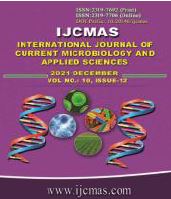


 National Academy of Agricultural Sciences (NAAS)
National Academy of Agricultural Sciences (NAAS)

|
PRINT ISSN : 2319-7692
Online ISSN : 2319-7706 Issues : 12 per year Publisher : Excellent Publishers Email : editorijcmas@gmail.com / submit@ijcmas.com Editor-in-chief: Dr.M.Prakash Index Copernicus ICV 2018: 95.39 NAAS RATING 2020: 5.38 |
Freshwater fish play a major role in feeding of people near to Nile river specially in Sudan. This study was conducted to investigate the pathogenic bacteria infected fish in Khartoum state. A total of 50 fish were examined at fish market in Khartoum city. The types of fish were 19 Nile tilapia (Oreochromis niloticus), 18 Synodontis (Synodontis schall), 3 Nile puffer (Tetraodon lineatus), 4 Bagrus catfishes (Bagrus bayad) and 6 Nile Perch (Lates niloticus). Fish subjected to postmortem and bacteriological examination. The common lesions were darkness of the skin, hemorrhage in the fins base, eyes and different parts of the body, abdominal distention, congested in gills and increasing in mucous secretion. The Postmortem findings showed white serous fluid in the abdominal cavity and sometimes tinged with blood and pale or congested liver and kidney. Three swab samples obtained from each fish from gill, liver and kidney. The bacteriological isolation and identification samples revealed that the prevalence of bacterial pathogens among naturally infected freshwater fishes were: Streptococcus iniae (21;14%), Staphylococcus aureus (47;31.3%), Salmonella spp (44;29.3%), Escherichia coli (44; 29.3%) and Pseudomonas spp (17; 11.3%). In conclusion the bacteria identified in this study are considered as zoonotic bacteria of significant economic importance. It is recommended to raise the awareness of fish workers and consumers for possible biological hazard.
 |
 |
 |
 |
 |